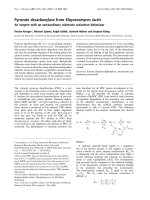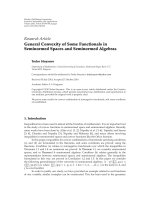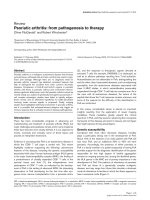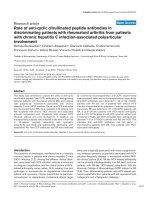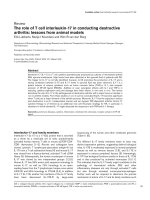Báo cáo y học: "rug discovery from Chinese medicine against neurodegeneration in Alzheimer’s and vascular dementia" pdf
Bạn đang xem bản rút gọn của tài liệu. Xem và tải ngay bản đầy đủ của tài liệu tại đây (275.77 KB, 6 trang )
REVIE W Open Access
Drug discovery from Chinese medicine against
neurodegeneration in Alzheimer’s and vascular
dementia
Yuen-Shan Ho
1*
, Kwok-Fai So
1,2,3
and Raymond Chuen-Chung Chang
1,2,3*
Abstract
Alzheimer’s disease and vascular dementia are two major diseases associated with dementia, which is common
among the elderly. While the etiology of dementia is multi-factorial and complex, neurodegeneration may be the
major cause of these two diseases. Effective drugs for treating dementia are still to be discovered. Current western
pharmacological approaches against neurodegeneration in dementia develop symptom-relieving and disease-
modifying drugs. Current integrative and holistic approaches of Chinese medicine to discovering drugs for
neurodegeneration in dementia include (1) single molecules from the herbs, (2) standardized extracts from a single
herb, and (3) herbal formula with definite composition. This article not only reviews the concept of dementia in
western medicine and Chinese medicine but also evaluates the advantages and disadvantages of these
approaches.
Introduction
Alzheimer’s disease (AD) and vascular dementia (VaD)
are the major forms of dementia. In addition, in the
postmortem brains of the late stage of Parkinson’sdis-
ease/Lewy body disease also find pathological hallmarks
of AD [1]. Senile dementia is the progressive decline of
memory and some related cognitive functions in the
elderly. The global dementia population is predicted to
reach 81.1 million by 2040 [2]. In 2010, the estimated
prevalence of senil e dementia in China is 6.0 to 7.0 mil-
lion, accounting for about one-sixt h of the global preva-
lence; the prevalence is expected to increase to 22.5
million by 2040, accounting for one-fourth of the global
prevalence by that time [3]. The rapid increase in the
number of dementia patients urgently demands effective
prevention and treatment. Current approaches to
dementia-related neurodegenerative diseases still highly
rely on relieving sympto ms. As some Chinese medicinal
herbs have been used in treating dementia, many
researchers are now turning to Chinese medicine for
identifying potential neuroprotective agents or disease-
modifying agent. This article reviews the strategy in the
research of Chinese medicine in dementia related-neu-
rodegenerative diseases.
Dementia and medical sciences
AD is clinically characterized by the progressive loss of
memory, cognitive functions and behavioral changes.
The pathogenesis of AD has been widely studied [4,5],
in w hich beta-amy loid (Ab) peptide and hyperpho-
sphorylated tau protein as components of extracellular
senile plaques and intracellular neurofibrillary tangles,
respectively, are believed to be the targets for developing
disease-modifying d rugs. Current AD treatments are all
symptom- relieving agents and heavily rely on the use of
acetylcholinesterase (AChE) inhibitors (donepezil, rivas-
tigmine and galantamine). AChE i nhibitors slow down
the degradation of the neurotransmitter acetylcholine,
thereby increasing i ts bioavailability. Another approved
AD treatment aims to reduce glutamate excitotoxicity.
Memantine, the only approved drug in this category,
acts as a non-competitive N-methyl-D-aspartate
(NMDA) receptor antagonist to reduce glutamate-
mediated neurotoxicity [6].
Development and progression of VaD are associated
with a number of risk factors, many of which are related
to the pathogenesis of atherosclerosis [7]. St roke is also a
critical factor for VaD; it was reported that 79.5% of VaD
* Correspondence: ;
1
Laboratory of Neurodegenerative Diseases, Department of Anatomy, The
University of Hong Kong Pokfulam, Hong Kong SAR, China
Full list of author information is available at the end of the article
Ho et al. Chinese Medicine 2011, 6:15
/>© 2011 Ho et al; licensee BioMed Central Ltd. This is an Open Access article distrib uted under the terms of the Creative Commo ns
Attribution License (http://c reativecommons.org/licenses/by/2.0), which permits unrestricted use, distribution, and rep roduction in
any medium, provided the original work is properly cited.
patients had a history of stroke [8]. As there is no cure
for VaD, management of VaD emphasizes on the preven-
tion of new stroke and control of vascular risk factors.
Dementia and Chinese medicine
According to Chinese medicine theory, there is no dis-
tinction between AD and VaD. Dementia is caused by
(1) deficiency of vital energy of th e Kidney (Shen), Mar-
row (Sui), Heart (Xin) and Spleen (Pi) and (2) stagnation
of Blood (Xie)and/orPhlegm(Tan). Thus, herbs used
for dementia are not specific for the nervous system but
tend to be multi-functional [9].
Standardization of dementia subtype classification and
research guidelines
Guideline for Chinese Medicine Diagnosis, Classification
and Clinical Rese arch of Senile Dementia was publis hed
in 1990. The guideline classified dementia into six sub-
types according to the CM theory: (1) the Bone Marrow
(Gusui) deficiency syndrome, (2) the Liver (Gan)and
Kidney (Shen) Yin deficiency syndrome, (3) the Spleen
( Pi)andKidney(Shen) Yang deficiency syndrome, (4)
the Qi stagnation and Blood (Xie) stasis syndrome, (5)
the Phlegm Turbid (Tan Zhuo) blocking Orifice (Qing
Qiao) syndrome, and (6) the Heart (Xin) and Liver F ire
( Gan Huo) syndrome [10]. Since then, clinical studies
on dementia in China have been based on this guideline
[11]. More recently, the Guideline Principles for Clinical
Research on New Chinese Medicine (trial version) [3]
provides more detailed description on the diagnostic cri-
teria and describes the severity of disease subtypes
quantitatively. The Mini-Mental State Examination
(MMSE) score has also been introduced as the main
reference index [3]. Criteria for the Diagnosis, Differen-
tiation of Syndrome and Evaluation of Efficacy of Vascu-
lar Dementia for Research Studies were published on
2002, emphasizing that the diagnosis of VaD must meet
the NINDS-AIREN criteria (developed by the National
Institute of Neurological Disorders and Stroke (NINDS)
and the Association Internati onale pour la Recherche et
l’Enseignement en Neurosciences (AIREN)) and that the
differentiation of syndromes in Chinese medicine should
be based on the scale for the differentiation of syn-
dromes of vascular dementia (SDSVD) published in
2000 [12]. It classifies VaD in 7 syndromes according to
CM diagnosis: (1) the Kidney Essence (Shen Jing)defi-
ciency syndrome, (2) the Phlegm Turbid (Tan Zhuo)
blocking Orifice (Qing Qiao)syndrome,(3)thevessels
obstructed by Blood Stasis (Xie Yu) syndrome, (4) the
brain aggressed by Liver’s(Gan) Yang syndrome, (5) the
Heat (Re)andToxin(Du) accumulation syndrome, (6)
the Qi and Blood (Xie) deficiency syndrome, and (7) the
constipation and toxin in intestines syndrome. SDSVD
employs a detailed scoring system to assist syndrome
differentiation and diagnosis [13].
Chinese medicine approaches based on the etiology of
dementia
Chinesemedicinetheoryconsidersdementiatobea
more holistic and integrated approach, rather than a
problem in just one organ. Dementia is complex and
may involve multiple causes. During progression of
dementia, the signi ficant of different pathological factors
may also change. In Chinese medicine, it is believed that
the disease is highly correlated to the abnormal func-
tions of other organs including the K idney (Shen), Liver
(Gan), Heart (Xin) and Spleen (Pi), although the patho-
logical site of dementia is in the brain. For example,
dementia patients who initially have Kidney (Shen)defi-
ciency may also develop stagnation of Blood (Xie)and
Phlegm (Tan) leading to dementia. All these clinical
experiences, stagnation of blo od and kidney deficiency,
become two important concepts in Chinese medici ne to
explain the origin of sickness leading to dementia
[14-16].
Chinese medicine studies on the prevalence and distribution
of dementia subtypes
In order to integrate Chinese medicine diagnosis, some
researchers investigated the prevalence and distribution
of dementia subtypes. Wang et al. found that deficiency
of Qi, Blood (Xie), Essence (Jing) was present in most
dementia cases and that Heart (Xin)andKidney(Shen)
were most commonly afflicted by the condition [17].
Yang et al. found that stagnation of Blood (Xie)and
Phlegm (Ta n) were frequently present in moderate and
severe AD cases [18]. While these data are not diagnos-
tic criteria, they provide important information for the
prevention of pathological progression in dementia.
Chinese medicine research on treatment of dementia
Nowa days, the development of Chinese herbal medicine
mainly adopted three approaches, which include the sin-
gle molecule approach, standardized extracted approach
and fixed herbal formula approach. In the following sec-
tions, we will discuss the recent development of each
approach. It is beyond the scope of our report to review
the pharmacological effects of all medicinal herbs for
dementia treatment in detail. I n fact, our aim is to use
several representative examples to illustrate the advan-
tages and disadvantages of each approach.
Single molecules from a single herb
Huperzine A Huperzine A is an alkaloid isolated from
Huperzia serrata (Qiancengta) which is documented in
Chinese medicine literature as an anti-inflammatory
herb for relieving pain and alleviating swelling after
trauma. According to the Chinese medicine theory,
Huperzia serrata helps removing Heat (Re)andhas
detoxification effects. Huperzine A is widely used in
China to treat AD. Clinical trials demonstrated that
huperzine A significantly improved cognitive functions
Ho et al. Chinese Medicine 2011, 6:15
/>Page 2 of 6
in AD patients [19] and its potential therapeutic effects
for VaD [20]. While evidence for the use of huperzine A
to treat AD was insufficient, a recent Cochrane systema-
tic review reported no obvious adverse effects in AD
patients treated with huperzine A [21].
The anti-AChE activity of huperzine A is the basis for
its use to treat dementia patients [22]. Animal studies
found that huper zine A was comparable to donepezil and
rivastigmine in terms of anti-AChE activity [23]. In vivo
studies showed that huperzine A affected amyloid pre-
cursor protein processing to reduce the formation of A b
peptides [24]. Other studies also showed that huperzine
A attenuated apoptosis in neurons treated with Ab pep-
tides [25]; and huperzine A elicited anti-oxidative effects
which allowed it to protect neurons against hydrogen
peroxide and Ab-induced oxidative damages [26,27].
Huperzine A was found to improve mitochondrial func-
tions in neurons and reduce the level of reacti ve oxygen
species in neurons exposed to Ab peptides [28].
Pros and cons of the single molecule approach Huper-
zine A is a chemical drug derived from Chinese medi-
cine as a chemical library [29]. The discovery of
huperzine A as an anti-AChE inhibitor was based on
the observation that the administration of Huperzia ser-
rata extract induced c holinergic stimulation in schizo-
phrenic patients [30]. As the quality and bioavailability
of a herb can be affected b y the cultivation environment
and harvesting season [31], single molecule approach
eliminates or minimizes this variation.
However, this approach may also generate problems.
Extraction of active ingredients is often not a simple
task. Interactions of ingred ients during preparation pro-
cedure are esse ntial to the therapy. Moreover, evidence
shows that s ingle component extracted from plants is
less potent than crude extract [32]. Researchers often do
not use any Chinese medicine theory as the basis for
their investigation when studying these compounds.
Therefore, some Chinese medicine experts are skeptical
about the approach [33].
Standardized extracts from a single herb
Authentication of herbs Historically, herbs grown in a
particular habitat are considered Daodi (genuine) [34].
Today, the good agricultural practice (GAP) promoted
in China ensures the quality and consistency of a parti-
cular herb [35]. A herbal extract is considered ‘standar-
dized’ if (1) the raw material (herb) is grown and
collected according to the GAP; (2) the extraction fol-
lows a well-defined procedure; and (3) the chemical pro-
files are consistent among batches of extracts.
EGb761 EGb761 is a standardized herbal extract from
the dried leafs of Ginkgo biloba, containing approxi-
mately 24% flavone glycosides (quercetin, kaempferol
and isorhamnetin) and 6% terpene lactones (ginkgolides
A, B, C, J and bilobalide) [36]. Dried fruit of Ginkgo
biloba is used in Chinese medicine to treat asthma and
coughing. W hile the chemical and biological prope rties
of individual EGb761 component have been investigated
in vitro and in vivo [37-39], the standardized extract
EGb761isoftenusedinclinicalresearch[40].A
Cochrane systematic review did not support the use of
EGb761 in dementia treatment [40]. Another report also
suggested that EGb761 was not effective in reducing the
incidence of AD [41]. Although clinical efficacy of
EGb761 for dementia treatment is still con troversial, the
use of a well-defined herbal extract in clinical studies
has been demonstrated.
Chinese medicine theories and anti-dementia drug
research Chin ese medicine theory and western pharma-
cology may be integrated f or the development of anti-
dementia Chinese herbal extracts. Accord ing to Chinese
medicine theory, the fruit of L. barbarum (Gouqizi),
which is used to tonify the Yin in our body, nourishes
our Eye (Yan), Liver (Gan)andKidney(Shen ); its anti-
aging effects are well-documented in Chinese medicine
literature [42]. In our laboratory, research of standar-
dized L. barbarum extract is based on Chinese medicine
concepts. Firstly, L. barbarum is chosen as the research
cand idate because of its unique Chine se medicine prop-
erties. Secondly, the research direction of our standar-
dized L. barbarum extract was inspired by Chinese
medici ne theory. Owing to anti-aging properties, L. bar-
barum may alleviate aging-associated neurodegenerative
diseases such as AD and VaD [9]. Quality control of our
raw materials ensured the quality of our L. barbarum
extract [43]. We found that L. barbarum extract attenu-
ated Ab peptide induced neuronal apoptosis [43]. The
holistic concept in Chinese medicine inspired us to
study the effects of the extract on other dementia
related pathological and risk factors. We then discovered
that L. barbarum extract protected neurons against glu-
tamate toxicity, suggesting that it might slow down
dementia progression [44]. We also demonstrated that
L. barbarum extract protected neurons against homo-
cysteine toxicity where hyperhomocysteinaemia is a risk
factor for AD [45].
Herbal formulations
Yokukansan Yokukansan, or TJ-54, is a Kampo herbal
remedy originating from the Chinese herbal formula
Yigan San developed in the Song Dynasty for the treat-
ment of Liver (Gan) dysfunction-induced agitation and
restlessness in children. Yigan San consists of seven
herbs, namely Angelica acutiloba (Danggui), Atracty-
lodes lancea (Baishu), Bupleurum falcatum (Chai hu),
Poria cocos (Fuling), Cnidium officinale (Chuanxiong),
Uncaria rhynchophylla (Gouteng) and Glycyrrhiza ura-
lensis (Gancao) at a ratio of 3:4:2:4:3:3:1.5. This compo-
sition is also used in Yokukansan [46] . Since this
remedy is used for the treatment of psychiatric disorder,
Ho et al. Chinese Medicine 2011, 6:15
/>Page 3 of 6
the possible therapeutic effects on dementia symptoms
are under investigation.
Both clinical and preclinical studies on Yokukansan
support its use in dementia treatment. A randomized,
observer-blind,controlledtrialfoundthata4-week
Yigan San treatment improved the behavioral and psy-
chological symptoms of dementia (BPSD) [47] which
includes aggression, agitation, screaming, wandering,
hallucinations and delusions. These symptoms develop
in 20-80% of dementia patients at different stages [48].
Yigan San reduced cholinesterase inhibitor-resistant
visual hallucination in a small group of patients of
dementia wit h Lewy bodies [49]. Positive effects of
Yokukansan on sleep disturbance in dementia patients
were also reported [50]. A randomized cross-over study
(sub jects receiving active treatmen t or placebo in diff er-
ent stages of the trial) found that Yokukansan signifi-
cantly improved the BPSD in AD patients but had no
effects on their cognitive functions as demonstrated by
the MMSE score. Effects of Yokukansan could persist
for one month and was well-tolerated [51]. Other stu-
dies also found t hat Yokukansan was safe and effective
in treating BPSD in AD and even PD patients [52,53].
Yokukansan might modulate the glutamatergic neuro-
transmitter system; hence protect ing neurons against
excitotoxicity [54,55]. Yokukansan provided direct pro-
tection on neurons or through modulating the gluta-
mate reuptake by astrocytes [56]. Yokukansan also
affected the expression of serotonin receptor in the
frontal cortex of mice injected with 2,5-dimethoxy-4-
iodoamphetamine [57].
Challenges in developing anti-dementia herbal for-
mulations Apart from Yigan San, some other Chinese
herbal formulae are effective in treating the dementia
[58,59]. Most of these studies are single clinical trials
performed on a single formula. There are few studies
on action mechanisms. Moreov er, few studies use Chi-
nese medicine diagnostic criteria. In other words, the
effects of a definite formula were tested on p atients
regardless of their dementia subtype in Chinese medi-
cine diagnosis. As exemplified in a clinical trial for
respiratory diseases, it should be feasible to incorporate
Chinese medicine diagnosis in the clinical trials for
dementia [60].
Conclusion
While Chinese herbal medicine is considered a big che-
mical library, potential drugs of single molecules have
been developed for the treatment of AD and VaD but
Chinese medicine concepts have not been fully incorpo-
rated for new drug development in Chinese medicine.
As Chinese medicine aims to restore harmony of the
whole body rather than only target the brain in treating
encephalopathy [61], further research into experimental
and clinical sciences should be conducted to explain
how Chinese medicine can treat and prevent AD and
VaD.
Abbreviations
AD: Alzheimer’s disease; Aβ: beta-amyloid; AChE: acetylcholinesterase; BPSD:
behavioral and psychological symptoms of dementia; MMSE: Mini-Mental
State Examination; NINDS-AIREN: National Institute of Neurological Disorders
and Stroke (NINDS) and the Association Internationale pour la Recherche et
l’Enseignement en Neurosciences (AIREN); SDSVD: scale for the
differentiation of syndromes of vascular dementia; VaD: vascular dementia.
Acknowledgements
The work of Chinese Medicine research in this laboratory is partly supported
by Azalea (1972) Foundation, The University of Hong Kong (HKU) Alzheimer’s
Disease Research Network under Strategy Research Theme on Healthy
Aging, HKU Strategic Research Theme on Drug Discovery, Area of Excellent
in Institute of Molecular Technology for Drug Discovery and Synthesis, and
HKU Technology Transfer Seed Funding.
Author details
1
Laboratory of Neurodegenerative Diseases, Department of Anatomy, The
University of Hong Kong Pokfulam, Hong Kong SAR, China.
2
Research Centre
of Heart, Brain, Hormone and Healthy Aging, LKS Faculty of Medicine, The
University of Hong Kong Pokfulam, Hong Kong SAR, China.
3
State Key
Laboratory of Brain and Cognitive Sciences, The University of Hong Kong
Pokfulam, Hong Kong SAR, China.
Authors’ contributions
KFS and RCCC contributed the main theme ideas. YSH wrote the
manuscript. All authors read and approved the final version of the
manuscript.
Competing interests
The authors declare that they have no competing interests.
Received: 8 December 2010 Accepted: 22 April 2011
Published: 22 April 2011
References
1. Alzheimer’s Association: Alzheimer’s disease facts and figures. Alzheimers
Dement 2010, 6:158-194.
2. Ferri CP, Prince M, Brayne C, Brodaty H, Fratiglioni L, Ganguli M, Hall K,
Hasegawa K, Hendrie H, Huang Y, Jorm A, Mathers C, Menezes PR,
Rimmer E, Scazufca M: Global prevalence of dementia: a Delphi
consensus study. Lancet 2005, 366:2112-2117.
3. Song Y, Wang J: Overview of Chinese research on senile dementia in
mainland China. Ageing Res Rev 2010, , Suppl 1: S6-12.
4. Querfurth HW, LaFerla FM: Alzheimer’s disease. N Engl J Med 2010,
362:329-344.
5. Iqbal K, Grundke-Iqbal I: Alzheimer neurofibrillary degeneration:
significance, etiopathogenesis, therapeutics and prevention. J Cell Mol
Med 2008, 12:38-55.
6. Mayeux R: Clinical practice. Early Alzheimer’s disease. N Engl J Med 2010,
362:2194-2201.
7. Gorelick PB: Risk factors for vascular dementia and Alzheimer disease.
Stroke 2004, 35(Suppl 1):2620-2622.
8. Lindsay J, Hebert R, Rockwood K: The Canadian study of health and
aging: risk factors for vascular dementia. Stroke 1997, 28:526-530.
9. Ho YS, So KF, Chang RCC: Anti-aging herbal medicine–how and why can
they be used in aging-associated neurodegenerative diseases? Ageing
Res Rev 2010, 9:354-362.
10. Fu RJ: Guidelines for TCM diagnosis, classification and clinical research of
senile dementia. J Tradit Chin Med 1991, 2:56-57.
11. Fu RJ, Luo SW: Review on clinical research of senile dementia treated by
TCM. J Beijing University of TCM 1994, 3:146-152.
12. Tian JZ, Ming XH, Jin WT: Criteria for the diagnosis, the differentiation of
syndrome and the evaluation of efficacy of vascular dementia for
research studies. Chin J Gerontol 2002, 5:329-331.
Ho et al. Chinese Medicine 2011, 6:15
/>Page 4 of 6
13. Tian JZ, Han XM, Yue JM, Yang CZ, Yang HM, Zou YH, Liu X: The scale for
the differentiation of syndromes of vascular dementia (SDSVD). J Beijing
University TCM 2000, 23:16-24.
14. Dong HT, Jin YG: A discussion on the etiology and pathogenesis of
senile dementia due to stagnation of blood-stasis in the orifice. Nanjing
University of TCM 2003, 35:3-4.
15. Zhang G, Wang FW: Recent progress in Chinese medicine clinical
research on vascular dementia. Lishizhen Med Mater Med Res 2010,
3:769-771.
16. Yuen DP, Qiu XF, Wang P, Zhou AF: Deficiency of kidney and febility of
marrow, blockage of brain vollateral: basic pathogenesis of Alzheimer’s
disease (AD). Zhonghua Zhongyiyao Zazhi 2008, 8:732-734.
17. Wang XY, Liu CP, Chen YW: Recent progress in TCM research on
Alzheimer’s disease pathogenesis. Neimengguz Zhong Yi Yao 2008,
12:62-64.
18. Yang BC, Liu RR, Xue RH, Ye SL: Research on TCM pattern identification in
dementia of the Alzheimer type. Shanghai J Tradit Chin Med 2000, 4:12-14.
19. Wang BS, Wang H, Wei ZH, Song YY, Zhang L, Chen HZ: Efficacy and
safety of natural acetylcholinesterase inhibitor huperzine A in the
treatment of Alzheimer’s disease: an updated meta-analysis. J Neural
Transm 2009, 116:457-465.
20. Wang R, Yan H, Tang XC: Progress in studies of huperzine A, a natural
cholinesterase inhibitor from Chinese herbal medicine. Acta Pharmacol
Sin 2006, 27:1-26.
21. Li J, Wu HM, Zhou RL, Liu GJ, Dong BR: Huperzine A for Alzheimer’s
disease. Cochrane Database Syst Rev 2008, , 2: CD005592.
22. Ma X, Tan C, Zhu D, Gang DR, Xiao P: Huperzine A from Huperzia
species–an ethnopharmacolgical review. J Ethnopharmacol 2007,
113:15-34.
23. Liang YQ, Tang XC: Comparative studies of huperzine A, donepezil, and
rivastigmine on brain acetylcholine, dopamine, norepinephrine, and 5-
hydroxytryptamine levels in freely-moving rats. Acta Pharmacol Sin 2006,
27:1127-1136.
24. Zhang HY, Yan H, Tang XC: Huperzine A enhances the level of secretory
amyloid precursor protein and protein kinase C-alpha in
intracerebroventricular beta-amyloid-(1-40) infused rats and human
embryonic kidney 293 Swedish mutant cells. Neurosci Lett 2004,
360:21-24.
25. Xiao XQ, Zhang HY, Tang XC:
Huperzine A attenuates amyloid beta-
peptide
fragment 25-35-induced apoptosis in rat cortical neurons via
inhibiting reactive oxygen species formation and caspase-3 activation.
J Neurosci Res 2002, 67:30-36.
26. Wang R, Xiao XQ, Tang XC: Huperzine A attenuates hydrogen peroxide-
induced apoptosis by regulating expression of apoptosis-related genes
in rat PC12 cells. Neuroreport 2001, 12:2629-2634.
27. Xiao XQ, Wang R, Tang XC: Huperzine A and tacrine attenuate beta-
amyloid peptide-induced oxidative injury. J Neurosci Res 2000, 61:564-569.
28. Gao X, Tang XC: Huperzine A attenuates mitochondrial dysfunction in
beta-amyloid-treated PC12 cells by reducing oxygen free radicals
accumulation and improving mitochondrial energy metabolism.
J Neurosci Res 2006, 83:1048-1057.
29. Pan SY, Chen SB, Dong HG, Yu ZL, Dong JC, Long ZX, Fong WF, Han YF,
Ko KM: New perspectives on Chinese herbal medicine (Zhong-Yao)
research and development. Evid Based Complement Alternat Med 2010,
2011:403709.
30. Wang Y, Huang LQ, Tang XC, Zhang HY: Retrospect and prospect of
active principles from Chinese herbs in the treatment of dementia. Acta
Pharmacol Sin 2010, 31:649-664.
31. Anekonda TS, Reddy PH: Can herbs provide a new generation of drugs
for treating Alzheimer’s disease? Brain Res Rev 2005, 50:361-376.
32. Luo Q, Cai Y, Yan J, Sun M, Corke H: Hypoglycemic and hypolipidemic
effects and antioxidant activity of fruit extracts from Lycium barbarum.
Life Sci 2004, 76:137-149.
33. Normile D: Asian medicine. The new face of traditional Chinese
medicine. Science 2003, 299 :188-190.
34. Leung PC, Cheng KF: Good agricultural practice (GAP) -Does it ensure a
perfect supply of medicinal herbs for research and drug development?
Int J Appl Res Nat Prod 2008, 1:1-8.
35. Zhang B, Peng Y, Zhang Z, Liu H, Qi Y, Liu S, Xiao P: GAP production of
TCM herbs in China. Planta Med 2010, 76:1948-1955.
36. Clostre F: Ginkgo biloba extract (EGb 761). State of knowledge in the
dawn of the year 2000. Ann Pharm Fr 1999, 57(Suppl 1):1S8-88.
37. Chen WD, Liang Y, Xie L, Lu T, Liu XD, Wang GJ: Pharmacokinetics of the
ginkgo B following intravenous administration of ginkgo B emulsion in
rats. Biol Pharm Bull 2007, 30:1-5.
38. Lee TF, Chen CF, Wang LC: Effect of ginkgolides on beta-amyloid-
suppressed acetylocholine release from rat hippocampal slices. Phytother
Res 2004, 18:556-560.
39. Zhou LJ, Zhu XZ:
Reactive oxygen species-induced apoptosis in PC12
cells
and protective effect of bilobalide. J Pharmacol Exp Ther 2000,
293:982-988.
40. Birks J, Grimley EJ: Ginkgo biloba for cognitive impairment and dementia.
Cochrane Database Syst Rev 2009, , 1: CD003120.
41. Dekosky ST, Williamson JD, Fitzpatrick AL, Kronmal RA, Ives DG, Saxton JA,
Lopez OL, Burke G, Carlson MC, Fried LP, Kuller LH, Robbins JA, Tracy RP,
Woolard NF, Dunn L, Snitz BE, Nahin RL, Furberg CD: Ginkgo biloba for
prevention of dementia: a randomized controlled trial. JAMA 2008,
300:2253-2262.
42. Chang RCC, So KF: Use of Anti-aging Herbal Medicine, Lycium barbarum,
Against Aging-associated Diseases. What Do We Know So Far? Cell Mol
Neurobiol 2007, 28:643-652.
43. Yu MS, Leung SK, Lai SW, Che CM, Zee SY, So KF, Yuen WH, Chang RCC:
Neuroprotective effects of anti-aging oriental medicine Lycium
barbarum against beta-amyloid peptide neurotoxicity. Exp Gerontol 2005,
40:716-727.
44. Ho YS, Yu MS, Yik SY, So KF, Yuen WH, Chang RCC: Polysaccharides from
wolfberry antagonizes glutamate excitotoxicity in rat cortical neurons.
Cell Mol Neurobiol 2009, 29:1233-1244.
45. Ho YS, Yu MS, Yang XF, So KF, Yuen WH, Chang RCC: Neuroprotective
effects of polysaccharides from wolfberry, the fruits of Lycium
barbarum, against homocysteine-induced toxicity in rat cortical neurons.
J Alzheimers Dis 2010, 19:813-827.
46. Mizoguchi K, Tanaka Y, Tabira T: Anxiolytic effect of a herbal medicine,
yokukansan, in aged rats: Involvement of serotonergic and
dopaminergic transmissions in the prefrontal cortex. J Ethnopharmacol
2010, 127:70-76.
47. Iwasaki K, Satoh-Nakagawa T, Maruyama M, Monma Y, Nemoto M,
Tomita N, Tanji H, Fujiwara H, Seki T, Fujii M, Arai H, Sasaki H: A
randomized, observer-blind, controlled trial of the traditional Chinese
medicine Yi-Gan San for improvement of behavioral and psychological
symptoms and activities of daily living in dementia patients. J Clin
Psychiatry 2005, 66:248-252.
48. Lawlor BA: Behavioral and psychological symptoms in dementia: the role
of atypical antipsychotics. J Clin Psychiatry 2004, 65(Suppl 11):5-10.
49. Iwasaki K, Maruyama M, Tomita N, Furukawa K, Nemoto M, Fujiwara H,
Seki T, Fujii M, Kodama M, Arai H: Effects of the traditional Chinese herbal
medicine Yi-Gan San for cholinesterase inhibitor-resistant visual
hallucinations and neuropsychiatric symptoms in patients with
dementia with Lewy bodies. J Clin Psychiatry 2005, 66:1612-1613.
50. Shinno H, Inami Y, Inagaki T, Nakamura Y, Horiguchi J: Effect of Yi-Gan San
on psychiatric symptoms and sleep structure at patients with behavioral
and psychological symptoms of dementia. Prog Neuropsychopharmacol
Biol Psychiatry 2008, 32:881-885.
51. Mizukami K, Asada T, Kinoshita T, Tanaka K, Sonohara K, Nakai R,
Yamaguchi K, Hanyu H, Kanaya K, Takao T, Okada M, Kudo S, Kotoku H,
Iwakiri M, Kurita H, Miyamura T, Kawasaki Y, Omori K, Shiozaki K, Odawara T,
Suzuki T, Yamada S, Nakamura Y, Toba K: A randomized cross-over study
of a traditional Japanese medicine (kampo), yokukansan, in the
treatment of the behavioural and psychological symptoms of dementia.
Int J Neuropsychopharmacol 2009, 12:191-199.
52. Kawanabe T, Yoritaka A, Shimura H, Oizumi H, Tanaka S, Hattori N:
Successful treatment with Yokukansan for behavioral and psychological
symptoms of Parkinsonian dementia. Prog Neuropsychopharmacol Biol
Psychiatry 2010, 34:284-287.
53.
Okahara K, Ishida Y, Hayashi Y, Inoue T, Tsuruta K, Takeuchi K, Yoshimuta H,
Kiue K, Ninomiya Y, Kawano J, Yoshida K, Noda S, Tomita S, Fujimoto M,
Hosomi J, Mitsuyama Y: Effects of Yokukansan on behavioral and
psychological symptoms of dementia in regular treatment for
Alzheimer’s disease. Prog Neuropsychopharmacol Biol Psychiatry 2010,
34:532-536.
Ho et al. Chinese Medicine 2011, 6:15
/>Page 5 of 6
54. Takeda A, Itoh H, Tamano H, Yuzurihara M, Oku N: Suppressive effect of
Yokukansan on excessive release of glutamate and aspartate in the
hippocampus of zinc-deficient rats. Nutr Neurosci 2008, 11:41-46.
55. Takeda A, Tamano H, Itoh H, Oku N: Attenuation of abnormal glutamate
release in zinc deficiency by zinc and Yokukansan. Neurochem Int 2008,
53:230-235.
56. Kawakami Z, Kanno H, Ueki T, Terawaki K, Tabuchi M, Ikarashi Y, Kase Y:
Neuroprotective effects of yokukansan, a traditional Japanese medicine,
on glutamate-mediated excitotoxicity in cultured cells. Neuroscience 2009,
159:1397-1407.
57. Egashira N, Iwasaki K, Ishibashi A, Hayakawa K, Okuno R, Abe M, Uchida N,
Mishima K, Takasaki K, Nishimura R, Oishi R, Fujiwara M: Repeated
administration of Yokukansan inhibits DOI-induced head-twitch
response and decreases expression of 5-hydroxytryptamine (5-HT)2A
receptors in the prefrontal cortex. Prog Neuropsychopharmacol Biol
Psychiatry 2008, 32:1516-1520.
58. Zhu AH, Tian JZ, Zhong J, Yang CZ, Shi J, Yin JX: A clinical study on a
randomized, double-blind control of Chinese medicine granules in
treatment of vascular dementia. Zhongguo Zhong Yao Za Zhi 2006,
31:1722-1725.
59. Du GY, Zhu XC, Zhao JJ, Wang J, Tian JZ, Liu XF, Zhi HP, Zhao Y, Cao CY,
Cui HF, Wang XR, Zhang CY: Clinical study of effect of tianzhi granule on
senile vascular dementia. Zhongguo Zhong Yao Za Zhi 2003, 28:73-77.
60. Lam CLK, Wong W, Fong DY: Chinese herbal medicine in the treatment
of acute upper respiratory tract infection: a randomised, double blind,
placebo-controlled clinical trial. Hong Kong Med J 2009, 15(Suppl 6):30-34.
61. Liu W, Zhang GL, Wang XL: Application and prospects of fan-sui relation
in TCM in preventing and treating encephalopathy. Zonghua Zhongyiyao
Za Zhi 2010, 25:993-996.
doi:10.1186/1749-8546-6-15
Cite this article as: Ho et al.: Drug discovery from Chinese medicine
against neurodegeneration in Alzheimer’s and vascular dementia.
Chinese Medicine 2011 6:15.
Submit your next manuscript to BioMed Central
and take full advantage of:
• Convenient online submission
• Thorough peer review
• No space constraints or color figure charges
• Immediate publication on acceptance
• Inclusion in PubMed, CAS, Scopus and Google Scholar
• Research which is freely available for redistribution
Submit your manuscript at
www.biomedcentral.com/submit
Ho et al. Chinese Medicine 2011, 6:15
/>Page 6 of 6




